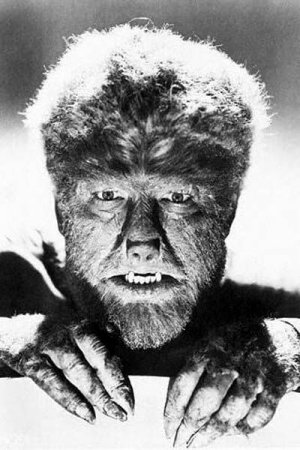A Werewolf in 1960s Italy January 16, 2011
Author: Beach Combing | in : Contemporary , trackbackRegular readers will know that Beachcombing has no great love for sociologists, who are to historians (or should be to historians) what garlic is to a vampire. However, he makes an exception for Belden Paulson’s brilliant The Searchers (1966) a description of life in a small Italian town, Castelfuoco (not its real name!), in the 1960s. Rereading this classic Beachcombing came across a reference to a werewolf that he had not previously registered. He offers it – fully expecting to be slapped down: drbeachcombingATyahooDOTcom – as the most recent werewolf report from western Europe.
Garibaldi del Trucco was the first one to encounter the ‘beast man’ while returning home late one evening from one of his interminable poker games. The moon was full. As he walked down the Corso degli Scalzi, only the splashing of the many aged and scarred fountains interrupted the profound stillness. In order to chase away apprehensive thoughts that dogged his solitary shadow, he whistled a loud cheerful aria. As he reached the crest of the Vicolo della Lumaca [Alley of the Snail], near the fountain of the Pilotta, he saw what seemed to be a man, with eyes flaming like two firebrands and ‘fingernails’ that would be the envy of any cat. ‘Jesu! What is he? I must escape… but what if he follows and catches up with me just as I reach my door? Aiee, no, per carità! Better to crouch here in the shadows…’ The monster had not moved a centimetre; only his features and claws grew nastier. Garibaldi invoked all the holy spirits in purgatory. As the minutes dragged on, the creature started an animal grunting which grew to piercing howls. He clawed at and crawled over the low wall surrounding the fountain. From his torn hands drops of dark red splashed into the turbid water. ‘Good fellow, just let me pass’, Garibaldi nearly croaked out but the words strangled in his throat. He thought of screaming aloud the name of his wife, but his house was located at the bottom of the Avenue of the Dead, the farthest corner of Castelfuoco where only spiders and snails ventured out. ‘If I survive’, he promised himself ‘I will change houses. I will give up poker…’ Meanwhile, the werewolf was flinging himself around convulsively in the water, satisfying some mysterious animal drive to bathe himself. Garibaldi thought the time had come to flee. But to reach the shelter of the Vicolo della Lumaca ten meters away he would have to pass in front of the creature. Another eternity went by. The purple shadows began to give way to a pale light. At this point the werewolf’s baying died to almost imperceptible moans, and rapidly his ‘monster’ semblance changed to a human one. A last shuddering dip into the fountain, a last hoarse roar and he was liberated from his nightmare. The werewolf passed quietly by Garibaldi del Trucco, who was having difficulty staving off a violent attack of nervous diarrhoea. The latter dove into the Vicolo and a few seconds later flung himself onto his sleeping wife who grumbled at this unwonted aggression.
Nor was Garibaldi alone: others in the town, including the normally unflappable Paulson, had heard the wolf cry and so a group of young toughs decided to set themselves the task of catching this solitary creature.
Some of the idle young bucks, the vitelloni [idle young men], saw in the situation a unique kind of adventure. ‘Tonight those of you with strong livers will come with me to catch the werewolf’, their leader announced. As the same swollen moon glanced over the rooftops, the small band stationed itself silently under an arch near the Fountain of the Pilotta. Everyone held his breath in anticipation and fear. Then the werewolf vaulted into the tiny piazza and began to undress slowly, as if in a trance. Under the white brilliance of the moon his bare figure was even more terrifying. With two shrill howls the unfortunate creature began sloshing water over himself, and at this moment the spectators rushed whooping toward him. The werewolf responded with an even more terrible shriek, leaped from the water, and fell to the cobblestones as if mortally wounded. For an instant the vitelloni remained riveted. No one believed his own eyes. The werewolf was no more than a timid day labourer of Castelfuoco who lived for his work in the fields and the sacred evening mass. But on nights of the full moon, he came forth questing for water with wolflike sounds and strength.
If this was anything but a sociologist at work this report would have been forgotten: as soon as mental illness was revealed as the cause the wolf man became an embarrassment to the town. But imagine if ‘the timid day labourer’ had been living in Italy in 1600. The chances are about two to one that he would have ended his life on the stake. As it is we have a precious account here from a community that was only just leaving the Middle Ages behind in the late twentieth century.
Beachcombing does not make a habit of quoting sociologists but for Paulson he’ll make an exception:
In such a small rural town, where history becomes legend, where the miracles of the shrine are as much a part of one’s existence as the spaghetti he eats, where communism to its believers takes on the metaphysics of something more than a political movement, where the supernatural and natural become fused, there is little knowledge of mental illness. So it is not surprising that exaggerated, other worldly-myths have grown up around the local ‘werewolf’.
Beachcombing has put the full account in his new source section.



